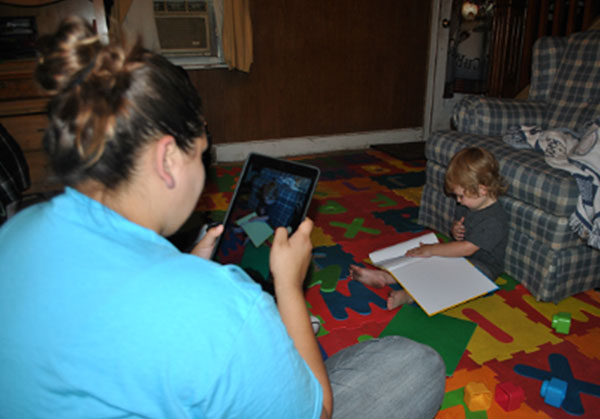 For decades, home-based programs have been thinking through and establishing policies for how to respond to a growing variety of technology. Now, the use of technology is extremely widespread. In many ways, that has been useful for home visitors. For example, you are accessing this information through your computer or mobile device. However, the home visitor's use of technology can also be disruptive of the ongoing interactions.
For decades, home-based programs have been thinking through and establishing policies for how to respond to a growing variety of technology. Now, the use of technology is extremely widespread. In many ways, that has been useful for home visitors. For example, you are accessing this information through your computer or mobile device. However, the home visitor's use of technology can also be disruptive of the ongoing interactions.
Home visitors often struggle with how to get parents and children to be engaged if the television is on or a parent is texting on their phone. However, families may also struggle when the home visitor introduces cameras, tablets, or laptops into the home visiting experience. It is important to discuss the purpose of using technology and how comfortable the family is with the equipment.
Here are some considerations about technology in home visiting.
Laptops and Tablets
Many curricula for home visiting have online assessments, planning forms, and suggestions for experiences and interactions. One benefit is that you and the parents can look at the screen together, write reflections on this home visit, and plan for the next one on a form that can be filled and saved directly in the program's system. Another is the capacity of a tablet to take photos and videos. If you have a portable printer, you can share the photos or the planning sheet immediately.
However, looking at a screen together is not the same experience as looking into each other's eyes and at facial expressions and gestures. Screen time should be used judiciously and should never be allowed to drive the conversation. The screen must never create a barrier between you and the parents.
Cameras
Digital still and video cameras, and smartphones with those capacities, make a wonderful contribution to documentation and portfolio assessment. Some programs keep videos of a child on a flash drive and give it to the parents when they leave the program. Photos can be used for parents to make memory books or books for their child. You can look at photos or videos with the parents and discuss your impressions of what the child is doing and learning.
As in the use of a tablet, you need to be sure you are not participating in the visit from behind a camera. Even if it would be wonderful to document everything that happens, you don't want to let the camera get between you, parents, and children. You must also be sure the parents understand how you will use the pictures and have them sign a consent form for you to photograph them and their child.
Portable Printers
These may be too much of an expense for most programs, but it is wonderful to print forms and photos in the moment.
Cell Phones or Smartphones
You may use a phone to take photos or video and use texting as a way to communicate with parents, but a phone can be very distracting when a parent is texting his or her way through your home visit. You might want to discuss the use of phones very early in your relationship so you have an agreement about putting them away and using this time to just be with the child. It may help parents if you explain that you are there to support their relationship with their child. You can tell them how important it is that in this moment their child has all of their attention.
Read more:
Resource Type: Article
National Centers: Early Childhood Development, Teaching and Learning
Last Updated: December 4, 2023
